Does Archaeology Prove the Bible is True?
Archaeology has been called “the Bible’s best friend,” a statement that reflects the long history of discoveries that support biblical records. From the discovery of the Cyrus Cylinder in 1879 to the Dead Sea Scrolls in 1947 to the Pool of Siloam in 2004, archaeology has worked hand in hand with Bible scholars to provide an independent witness to the truth of God’s Word.
Unfortunately for skeptics, archaeology has unearthed a mountain of evidence that proves that the Bible is not a collection of ancient fairy tales but an honest record of historical events.
The authors of the Bible make many archaeological claims. More than 50 people mentioned in the Bible have been confirmed through archaeological discoveries. This chapter shows how archaeology confirms and supports the Bible.
The great majority of supposed contradictions among the Bible, history, and archaeology are untrue or have been proven false. Some archaeological discoveries seem to contradict the Bible. Is it archaeology or the Bible that is in error? In such cases, remember that archaeologists are people, too, with their limitations, biases, and proneness to error. When an artifact is found, its existence and location must be interpreted, and it is the process of interpretation that is liable to mistakes.
Many secular archaeologists used to say that King David was a legendary figure, on par with King Arthur, rather than a historical king. Rather, that was their position until they found the Tel Dan Stela, a basalt stone dating from the ninth century B.C., bearing David’s name and identifying him as king of Israel. So, up until the stela was found, archaeology did not overtly support the Bible’s references to King David. But eventually, an archaeological find showed that the Bible was true all along. David was a real person who was king of Israel, and archaeological naysayers turned out to be wrong.
Many more archaeological discoveries have substantiated events and people in the Bible. In fact, archaeology has on many occasions provided tangible evidence for exactly what the Bible records. Egypt’s invasion of Israel (1 Kings 14:25); the Assyrian siege of Lachish (2 Kings 18-19); the trade relations between Israel and Sheba (1 Kings 10); the Babylonian conquest of Jerusalem; and the reigns of Kings Omri, Ahab, Uzziah, Hezekiah, Ahaz, Jeroboam II, and Jehoiachin (1 and 2 Kings) all are recorded in the Bible and all have been confirmed by archaeology. And, the discovery of the Dead Sea Scrolls—one of the most significant finds of the 20th century—was decisive proof of the reliability of the Bible’s manuscripts.
Some Crucial Archaeological Discoveries Related to the Bible
1. Rosetta Stone

In 1798, Napoleon invaded Egypt. He brought with him a scientific team of scholars and draftsmen to survey the monuments of the land. The most important find of the expedition was the Rosetta Stone. It proved to be valuable as the key to deciphering ancient Egyptian hieroglyphics.
The stone dates to the period of Ptolemy V (204-180 B.C.) and was inscribed in three scripts: demotic, Greek, and hieroglyphic. Greek, well known to scholars at the time, proved to be a translation of the ancient Egyptian language on the stone.
2. Dead Sea Scrolls
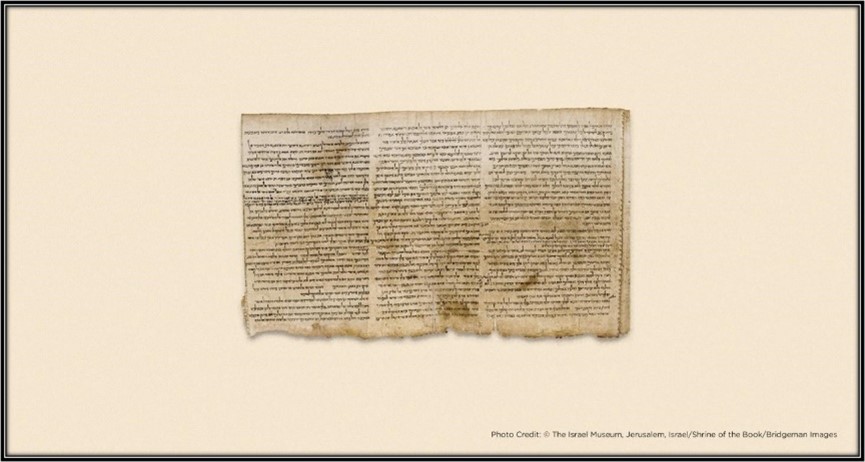
In 1947, shepherds stumbled upon a cave in a rugged, arid area on the western side of the Dead Sea. What they discovered was soon proclaimed the greatest archaeological find of the 20th century. Over the next few years, similar remote caves in the area were found. What did these caves contain? Over 800 fragmentary documents, mainly consisting of Hebrew writings on leather (with a few on parchment), including fragments of 190 biblical scrolls, were unearthed. Most of these were small, containing no more than one-tenth of a book; however, one complete Book of Isaiah scroll was found. Almost every Old Testament book, along with other valued writings, dwelt in those caves. The earliest scrolls date to the mid-third century B.C., and most to the first or second centuries.
Perhaps the greatest contribution of this find is to our understanding of the transmission of biblical text. The differences are minimal between the Old Testament texts of the Dead Sea Scrolls and various editions of the Hebrew texts produced 1,000 years later and used today, involving the smallest textual details. The meaning of the text itself is not affected by these differences.
3. Tel Dan Inscription
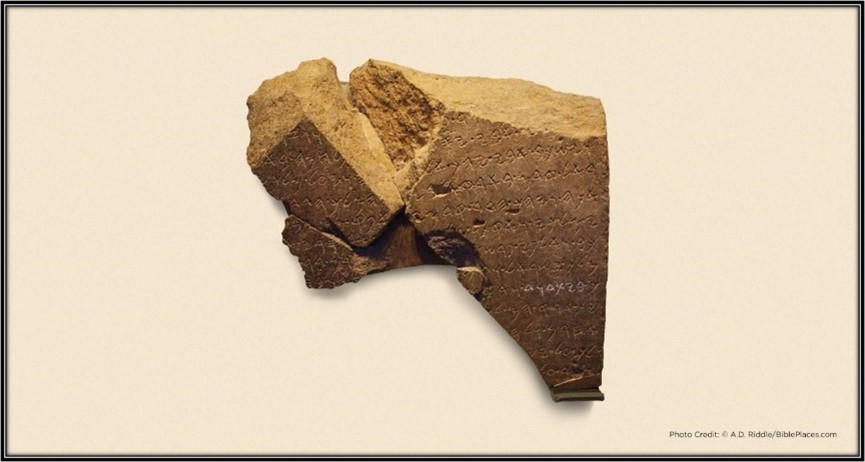
In 1993, excavators at Tel Dan uncovered an inscription with the word “BYDTWD” on it. They convincingly argued that the word means “House of David” and dates to the ninth century B.C. The inscription had been sealed by a later Assyrian destruction layer dated 733-722 B.C. An ash layer is an archaeologist’s dream. Anything sealed beneath it must be dated earlier because there is no possibility of intrusion by later artifacts. Pottery directly beneath the destruction layer dates to the ninth and eighth centuries B.C., and from this period the House of David inscription must have come.
Some scholars have attempted to explain away the inscription by asserting BYDTWD is either a place or a designation for a temple of a deity. However, it probably refers to the house of the lineage of David, the second king of the united monarchy and arguably the most significant ruler in the history of Israel. Additional evidence is the likely appearance of BYDTWD on the Mesha Stela/Moabite Stone, also dating to the ninth century B.C.
4. Ketef Hinnom Scroll Fragment

In 1979, Israeli archaeologist Gabriel Barkay was excavating a burial cave at Ketef Hinnom, just southwest of Jerusalem. The tomb was a typical late Iron Age (late-seventh-century B.C.) burial structure. The typical Judean burial at this time took place in a rock-cut cave. When a person died, he was placed on a burial bench in the tomb along with personal items such as vases, jewelry, or trinkets. When the body decayed, the bones of the person were placed in a box beneath the burial bench.
As the team began to excavate the box, they came upon two small silver scrolls. Because the scrolls were metal, the archaeologists had a difficult time unrolling and deciphering their text. They began with the larger of the two scrolls, which took three years to unroll. When unrolled, it measured only three inches (7.6 centimeters) long. When they finished, they noticed the scroll was covered with very delicately etched characters. The first word they were able to decipher was the name “Yahweh.”
After much work, they were able to read the entire scroll. It contained the priestly benediction from the Book of Numbers, chapter 6. The smaller scroll also contained the benediction from Numbers 6. It took so long to unroll and decipher the scrolls that the material was not published until 1989.
These two scrolls are relatively unknown, but they can be seen today in the Israel Museum in Jerusalem. They are the earliest known citations of biblical texts in Hebrew. They predate the earliest Dead Sea Scrolls by more than 400 years and are helpful in matters of textual criticism. Many authors have argued that the priestly benediction was written after the exile, with its earliest date from the fourth century B.C. Now we have physical examples of the benediction from the late-seventh-century B.C. In addition, the discovery of two plaques with the same benediction from a buried site underscores the centrality of the priestly benediction to the religion of the Israelites.
5. Moabite Stone
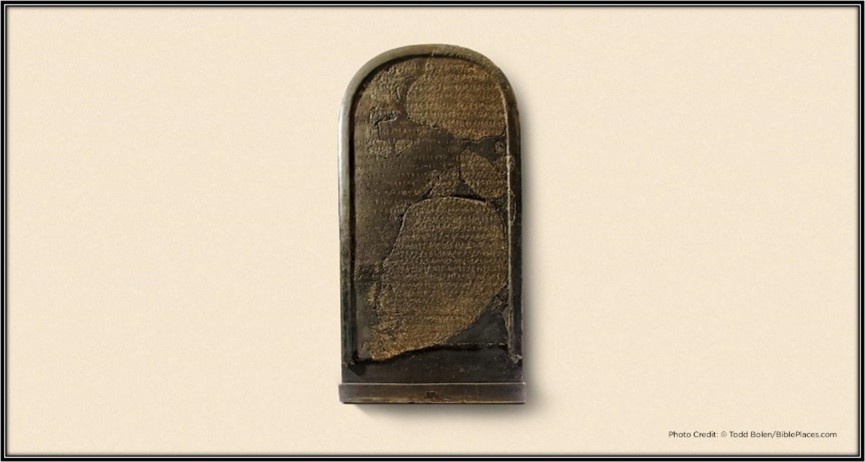
In 1868, a missionary in Jerusalem found a stone tablet for sale that appeared to be from ancient times. The sellers broke the tablet into several pieces to sell them one at a time to make more money. Fortunately, a copy of the tablet was made before the break (this copy is in the Louvre in Paris today). On the tablet is a text written in Moabite dating to the ninth century B.C. It was perhaps a victory stone erected by King Mesha to commemorate his military achievements. The text begins, “I am Mesha, son of Chemosh, King of Moab.”
Prominent in the text is the king’s version of a war fought with Israel in 850 B.C., in which Moab revolted against King Jehoram of the northern kingdom of Israel soon after the death of Ahab. The Bible records the same incident in 2 Kings 3. The two accounts differ in perspective. Mesha emphasizes his victories over Israel in capturing cities under Israeli control. The biblical writer, on the contrary, highlights Israel’s successful counterattacks against the Moabites.
6. Epic of Gilgamesh
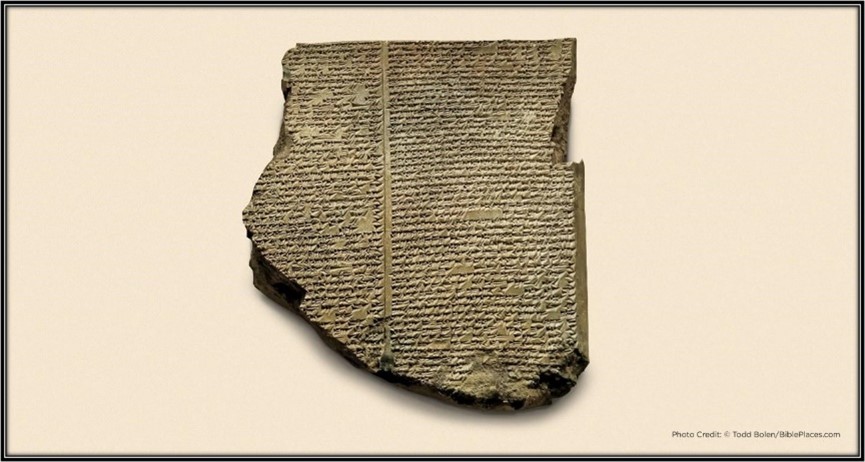
In 1872, archaeologist George Smith announced that he had discovered an Assyrian account of a flood among tablets stored in the British Museum from excavations of mid-seventh-century B.C. Nineveh.
This Epic of Gilgamesh story comprises 12 tablets, with one tablet containing a tale of a great deluge. The hero of the flood, a man named Utnapishtim, related an episode to Gilgamesh. He explained how the god “Ea” warned him about an approaching judgment and told him to build a boat to save his life from the watery onslaught. As the tale unfolded, the epic in some respects is nearly identical to the biblical narrative of Noah in Genesis chapters 6-9. This discovery created quite a stir among biblical scholars of the 19th century, and even today scholars continue to puzzle over and debate the obvious parallels between the two.
7. Crucified Man at Givat Hamivtar
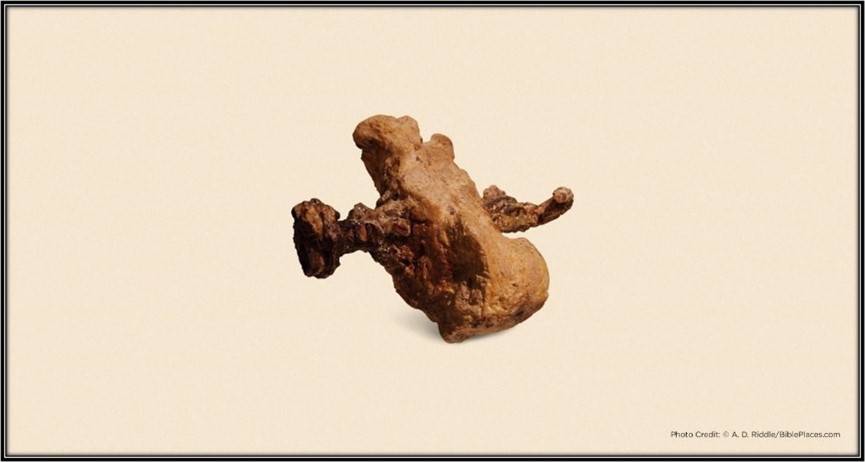
We are aware of Roman methods of crucifixion of the first century—not only from written records but also from the remains of a crucified man discovered at Givat Hamivtar, a site just outside Jerusalem. The cross consisted of two parts: the upright bar, called the stipes crucis, and the horizontal bar, called the patibulum. The crucified man was placed with his back over the stipes crucis, and his hands were nailed to the patibulum. According to archaeo-logists, the nails must have been driven through the wrist because the palms could not have supported a man’s weight.
He was affixed to the cross also by his feet, in a way different from what is commonly thought. The Roman executioner made a crude, rectangular frame of wood in which the heels of the victim were pressed. Then an iron nail was driven through the right part of the frame, through the man’s calcanei—the largest tarsal bones in the foot—and then through the left part of the frame. The free end of the nail was then bent by hammer blows. This find gives archaeologists further insight into Roman crucifixions.
–Adapted from the ESV Archaeology Study Bible, edited by Dr. John Currid and Dr. David Chapman
8. THE GREATEST DISCOVERY OF ALL – NOAH’S ARK

Noah’s Ark, which some have called a fairy tale or legend, has been found in the location the Bible refers to as the mountains of Ararat (Genesis 8:4). Noah’s Ark is the ship in the Genesis flood narrative through which God spares Noah, his family, and examples of all the world’s animals from a global deluge. The ark was hidden for centuries by glacial snow and ice. An earthquake in 1978 caused the earth to settle, exposing the ark’s ribs. In 1986, radar scans revealed the pattern of a structure. Turkey officially dedicated the site as Noah’s Ark in 1987. In 2014, radar scans revealed a massive boat shape under the ground.
As stated in chapter 2, God gave Noah the dimensions of the 1.5 million-cubic-foot ark he was to build. A ship was built after that same pattern in 1609 in Holland, revolutionizing shipbuilding. By 1900, every large ship on the high seas was inclined toward the proportions of the ark, verified by “Lloyd’s Register of Shipping” in the World Almanac. This is further proof of biblical accuracy and authenticity.
POINT TO PONDER: What is the significance of this discovery that hardened skeptics deny? Are we presently living in the days of Noah as we see evil abounding in the world? God’s judgment brought on the worldwide flood to stop the evil that covered the earth (Genesis 6:1-8). The rainbow in the sky was a sign God would not judge the world with a flood again (Genesis 9:13-15). The next judgment will be by fire (2 Peter 3:7-10). Is the recent discovery of Noah’s Ark a sign to the world? May we gain a deep revelation from this discovery. Jesus Christ is our lifeboat!
This discovery alone proves the authenticity of the flood account in the Book of Genesis. The links below will take you on a journey that will astound you!
DISCOVERY OF NOAH’S ARK: www.ronwyatt.com/noahs_ark
NOAH’S ARK RADAR SCANS: www.noahsarkscans.nz/
NOAH’S ARK AND OTHER DISCOVERIES: www.ronwyatt.com/
Note: Go to campusreset.org for more information regarding other archaeological site discoveries such as Sodom and Gomorrah, the Red Sea crossing, Ark of the Covenant, and Mount Sinai.
